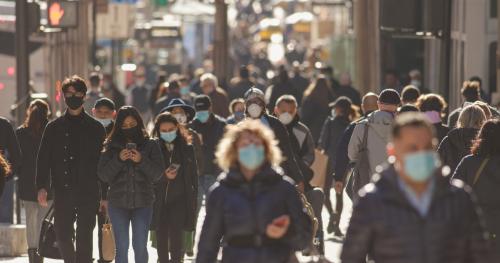This analysis focuses on the evolution of household balance sheets over the course of the COVID-19 pandemic. Balance sheets have been buffeted by many factors, including weakness in labor-market income, strength in federal benefits, increases in asset prices, increases in household debt, and pandemic-constrained consumer spending. In aggregate, the result has been that households’ financial positions in 2022 are significantly improved relative to 2019. Savings held in deposits and other financial accounts have increased, real estate and stock market wealth has increased, and borrower distress has decreased. That improvement in financial strength will be a source of support to the aggregate economic recovery in coming quarters.
The overall increase in after-tax and transfer income and the decrease in consumer spending have resulted in an extraordinary run-up in aggregate household savings. Although labor-market income was quite weak early in the pandemic, federal benefits more than compensated overall. In part as a result of relatively strong overall income growth, we estimate that households accumulated $2.5 trillion in excess savings (inflation-adjusted to 2020 dollars) between March 2020 and January 2022, much of which appears to have been deposited in checking and savings accounts.1 The difference is notable relative to the Great Recession, when income remained below its pre-recession trend for several years.
Since March 2020, many households were able to maintain their spending on essentials, and some households even saw increases in spending relative to 2019. This is a result of the increase in federal benefits and the eventual recovery in labor-market income: survey data show that people primarily spent the federal benefits that reached them early in the pandemic and used later benefits primarily to pay down debt as labor-market income increased. Nonetheless, total cumulative spending since early 2020 has been depressed. (Note that one program that lowered measured spending on personal interest payments was the forbearance program that paused payments on federally-owned student loans.)
Despite the documented increase in savings, the significant increase in wealth over the last two years was largely driven by increases in stock prices and real estate prices. Indeed, only a small portion of the $24 trillion total increase in real wealth from early 2020 through the end of 2021 reflects savings out of income.
Underlying the aggregate increases in savings and wealth is significant dispersion across different groups of households. For example, a number of researchers have estimated the distribution of excess savings among households—the savings out of income over and above what households would be expected to accumulate if the recent trends prior to the pandemic had been maintained—and find that a larger share of recent excess savings are held by lower-income households than historical patterns would suggest (Batty, Deeken, and Volz 2021; Hatzius et al. 2021). Nonetheless, the estimates show that the top income quintile holds a disproportionate share while the bottom 40 percent holds just about 20 percent of those savings. In addition, we break out the distribution of cumulative household wealth changes (excluding deposit accounts) by income, race and ethnicity, education, and age. We find nearly all groups have seen gains since 2019, but people with lower incomes and lower levels of education took the longest to recover. Among income groups, households with the lowest incomes saw the smallest wealth gains (excluding deposits), both in dollar terms and in percentage terms. That is in part because lower income groups are more likely to be renters rather than homeowners, meaning that instead of benefiting from the recent appreciation in house prices, they have faced significant increases in rents.
One factor included in those changes in wealth is an increase in total household debt, with an increase in mortgage debt that more than offset a decline in credit card debt. Despite an overall increase in borrowing, the increase in income and the decrease in interest rates on mortgages and consumer debt have resulted in declines in the debt-to-income ratio and the cost of servicing debt relative to income.
Delinquency rates and bankruptcies increased briefly in the beginning of the pandemic but continued their long-term downward trend in the months that followed. An eviction moratorium and federal and private forbearance policies on many types of debt have left households better off, in part by allowing many households to forego required interest payments. However, the result of the phase out of many of these programs remains to be seen.
An examination of the significant disparities in the improvements among different households suggests three points of concern.
An examination of the significant disparities in the improvements among different households suggests three points of concern. One, as remarkable as it is that fiscal support and the overall recovery have left most households no worse off than before the pandemic, many households continue to have precarious financial situations because they entered the pandemic in a precarious financial situation. Two, not all households were reached by fiscal support, the labor market recovery, and asset price increases; when coupled with recent and expected increases in rent, some households’ finances have worsened over the last two years. And, three, the pandemic is ongoing and most federal pandemic-related programs have wound down, putting household finances at risk as people face new health, employment, and financial problems.
EXCESS SAVINGS OVER RECENT TRENDS
Significant changes in labor-market income, government transfers, and the ability to consume goods and services have resulted in remarkably strong savings relative to pre-pandemic trends. Excess savings during the COVID period is defined as the difference between two measures. The first measure is the difference between actual disposable personal income (DPI) and the level of DPI if it had increased in 2020 and 2021 at the same average pace as over the 2018–19 period (“disposable income contribution” on figure 1b). The second measure is the difference between actual personal outlays and the level of outlays if they had continued at their pre-pandemic pace (“personal outlay contribution” on figure 1b). Because DPI was higher than trend in 2020 and 2021 and outlays were lower than trend (figure 1a), the result is excess savings out of income. From March 2020 through January 2022, elevated incomes contributed roughly $1.3 trillion while spending shortfalls contributed roughly $1.2 trillion to an estimated $2.5 trillion in excess savings held by households in inflation-adjusted 2020 dollars.2

The combination of robust income support and pandemic-constrained consumer spending has meant that some months have had extraordinarily high rates of saving. In April 2020, economic impact payments (EIPs) and expanded unemployment insurance (UI) benefits boosted real DPI by 14 percent and household saving as a percent of DPI reached a record high of 34 percent as real spending fell 18 percent relative to February; the result was more than $400 billion in excess savings in April 2020. In January and March 2021, the second and third rounds of EIPs led to additional spikes in the saving rate. The level of spending has been closer to trend since March 2021, and the level of DPI has remained quite close to trend since May. Overall, between March 2020 and January 2022 the monthly saving rate averaged 14 percent.
Income-Related Policy Changes and Labor Income
Much of the extraordinary strength in income since March 2020 is owed to government social benefits (see the orange bars in figure 2). In total from March 2020 through January 2022, government benefits well above their previous trend boosted real DPI more than $2.1 trillion. The three rounds of EIPs in March 2020, January 2021, and March 2021 delivered over $850 billion in total to households. Initially and intermittently, supplements to UI pushed wage replacement rates closer to or above 100 percent, and extensions in benefit durations sustained the increase in income. In early 2021, the American Rescue Plan made the Child Tax Credit (CTC) fully refundable and more generous, significantly increasing after-tax income for low-income families with children under the age of 18 in the household.

The stacked bars in figure 2 illustrate how the components of DPI contributed to increases in DPI relative to trend. Since March of 2020, households had a cumulative shortfall in labor compensation and other income (rent, interest, and dividends) of roughly $390 billion and $500 billion, respectively. And sole proprietors, who had recovered the entirety of their losses in aggregate by October 2020, in large part through forgivable loans from the Paycheck Protection Program, had earned nearly $150 billion in excess of pre-pandemic trend. In recent months, the level and growth of real DPI has returned back to its pre-pandemic trendline, as shown by the diamond-studded black lines on each bar falling back to zero.
Other programs helping to boost household resources but are not reflected in the measure of DPI have included forbearance programs that paused existing debt payments on the majority of federally-backed mortgages, in addition to provisions that allowed penalty-free early withdrawals from retirement plans; these policies provided a buffer of flexibility to either temporarily delay payments or to dip into previously restricted funds. Programs aiding businesses also played a role in indirectly supporting workers’ incomes; an example is the Paycheck Protection Program, which offered forgivable loans to small businesses under the condition they maintained their prior payrolls.
Spending and Saving Flows
Many households reported that federal income support boosted their planned spending early in the pandemic. A critical source of that support was the first round of EIPs, which reached households quickly, in as little as two weeks by direct deposit (Adamczyk 2020). In contrast, new unemployment insurance benefits were often delayed, sometimes by weeks (TrackTheRecovery.org n.d.).
More than 70 percent of respondents to the Census’ Household Pulse Survey (HPS) in June and July 2020 reported that they “mostly spent” or planned to mostly spend the first EIP (figure 3). Some researchers suggest that lower-income and younger households were among those who spent the EIP fastest, using a greater proportion of those funds for essential daily living expenses (Armantier et al. 2021; Greig, Deadman, and Pascal Noel 2021), while others found that 29 percent of the first EIP was used for consumption by the end of June 2020 (Armantier et al. 2020).
To be sure, the overall effectiveness of the first EIP cannot be measured solely by how much of it was spent. In spring of 2020, consumer spending was severely constrained by the health concerns and uncertainty regarding how long the crisis would last. Saving the EIP may have given households a small amount of much-needed financial security.

Survey evidence shows whether households used transfers, debt, or savings to support their spending (figure 4). While households reported that they were more likely to plan to use the second and third EIPs to increase savings or pay down debt, survey evidence also shows that many spent their EIPs just after they were issued (blue line in figure 4) while households increasingly used debt as a source of financing for spending over time. (Note that respondents may have included the use of credit cards here, with or without the accumulation of credit debt.) As employment partially recovered, households relied less over time on UI benefits to support spending.

Aggregate data show that much of the increase in household savings out of income ended up in deposit accounts. As shown in figure 5, the flow into deposits since the second quarter of 2020 has averaged close to $500 billion quarterly (in 2020 dollars), a much greater flow than prior to the pandemic. The cumulative increase in real deposits since early 2020 has totaled nearly $3.8 trillion, constituting the largest increase since 1951 when collection of this data began. In contrast to extraordinary flows into deposits, flows into equities and mutual funds and out of debt securities and money market funds have remained within their historical ranges.

Consistent with the survey evidence that early in the pandemic households used a portion of their fiscal support to pay down debt, the amount of consumer debt paid down exceeded new loan originations by more than $60 billion in the second quarter of 2020, the first quarterly decline in a decade. In contrast, mortgage borrowing has risen on net since the start of the pandemic, alongside the acquisition of real assets including residential property.
DEBT
Although aggregate household debt has risen by $444 billion (in 2020 dollars) since the end of 2019, incomes have risen faster. Household debt-to-DPI steadily declined in the decade before the pandemic but early in the pandemic, the speedy income support and decline in consumer debt resulted in a decline in the ratio to its lowest level since the mid-1990s (figure 6a). The ratio of debt service payments to DPI, shown in figure 6b, is a measure of the burden of servicing debt. Given the dramatic decline in interest rates on household debt, the significant increase in income, and the relatively modest increase in debt balances, that measure has remained near a series low since early 2021. All in all, the overall level and the burden of servicing households’ current debt balance do not appear to be a significant headwind for consumer spending.

The modest increase in household debt since early 2020 is predominantly driven by mortgage balances and to a lesser extent auto loans. Mortgage debt rose in 2020 and then again in 2021, for a cumulative increase of $680 billion (in 2020 dollars, figure 7). Auto loans are up a cumulative $35 billion over 2019. In contrast, credit card debt and home-equity lines of credit are both down since 2019 ($130 billion and $90 billion, respectively). The overall size of student loan debt has declined $30 billion through the end of 2021, owing to the U.S. Department of Education’s temporary pause on required payments for all federal loans through May 2021 and, likely, weakness in student enrollment (Bauer et al. 2021).

Mortgages
Much of the increase in mortgage debt appears to reflect homeowners borrowing to purchase more expensive homes. Average home prices increased by 30 percent from February 2020 to December 2021. At the same time, mortgage interest rates fell from 3.74 percent at the end of 2019 to a low of 2.65 percent in January 2021. Despite mortgage rates returning to pre-pandemic levels in recent months, the initial decline in interest rates led to a surge in refinancings. And, data for the third quarter of 2021 show that more than half of those borrowers refinanced into larger mortgages and thus “cashed-out” equity from their homes (Black Knight 2021).
Together, an increase in new mortgages and refinances have led to the first significant increase in mortgage debt since before the Great Recession. However, unlike the mid-2000s, the increase in mortgage borrowing has been concentrated among those with higher incomes and credit scores. For example, borrowers with super-prime scores above 760 have made up 70 percent of those taking out mortgages since early 2020, and subprime originations accounted for just 2 percent of the total; in contrast, super-prime borrowers made up 25 percent of originations between 2006 and 2007 while subprime borrowers made up 13 percent. In addition, home prices have appreciated at a rate outpacing the rise in mortgage debt. As a result, the loan-to-value for the housing market as a whole reached a twenty-five-year low (Agarwal et al. 2021). Conversely, not everyone has benefited from lower mortgage interest rates or higher home prices, and the rates of homeownership for minority households remain depressed (U.S. Census Bureau 2021b).
Credit Cards
The decline in credit card debt has been striking (see figure 8). Credit card balances fell $73 billion in the second quarter of 2020—the largest real quarterly decline on record. Through the end of 2021, credit card balances remained $130 billion lower than pre-pandemic levels. Estimates from the Federal Reserve Bank of New York suggest this aggregate decline reflects a reduction in credit card balances across income groups, showing that credit card balances declined in both high-income and low-income census tracts (Haughwout et al. 2021). Lender surveys show an easing of credit card terms and access (Board of Governors of the Federal Reserve System 2022d), and the average amount of unused credit per account has risen in line with the reduction in borrowing.

The recent decline in credit card borrowing likely reflects a number of factors. First, as noted above, households have used some of the significant fiscal support to pay down debt. Second, some households have pulled back on spending during the pandemic. Third, automatic forbearance for other categories of debt, such as student loans, freed up financial resources that could be used to pay down existing credit card balances.
The differences relative to post-2008 credit card activity are notable. A small decline in average balances in the second quarter of 2008 coincided with the issuance of federal benefits of up to $600 and $1,200 for singles and couples. In later quarters, credit card borrowing ballooned. At the same time, lenders tightened the credit available both in aggregate and per account. In total over the Great Recession 120 million credit card accounts were closed on net (Haughwout et al. 2019), and the number of total active accounts did not return to its 2008 peak until early in 2019.
WEALTH
Early in 2020 a decline in stock prices led to losses in equity holdings, pensions, and mutual funds of roughly $8 trillion. By the second quarter of 2020, those assets had recovered by $6 trillion. As home prices began to surge in the middle of 2020 and stock prices continued to rebound, asset prices accelerated. At the same time, net household saving added modestly to aggregate wealth. Total household wealth has increased by more than $24 trillion dollars from the end of 2019 through the end of 2021, driven primarily by rising asset prices and only secondarily by excess saving out of income (figure 9).

By the end of 2021, the increase in stock prices meant the value of equity holdings, pensions, and mutual funds had risen a cumulative $15.6 trillion in 2020 dollars from just before the pandemic. In addition, since the end of 2019 the market value of households’ real estate has risen roughly $8.3 trillion. Valuations for proprietors’ business equity have also jumped with the rise in other assets, contributing total net revaluations of $3.2 trillion. The contribution of household savings out of income, shown in purple in figure 9, has been roughly $4.9 trillion of the total $24 trillion wealth gain since 2019.
DISTRIBUTION OF CHANGES IN SAVINGS AND WEALTH
In this section, we break out the distribution of cumulative household wealth changes (excluding deposit accounts) by income, age, race, ethnicity, and level of education. Underlying the aggregate increases in wealth is uncertainty around the distribution of recent excess savings when arrayed by pre-pandemic household income. We show that historical holdings of wealth are a useful guide, finding that the highest-income groups saw the largest gains, both in percentage terms and in dollar terms. But several researchers find that a greater portion of recent savings is held by the bottom two income quintiles than historical patterns of savings would suggest (Batty, Deeken, and Volz 2021; Hatzius et al. 2021).
Distribution of Savings
The patterns of income loss and unemployment, consumption shifts, and government support over the course of the COVID-19 pandemic create challenges in estimating the distribution of roughly $2.5 trillion in real excess savings to households by income. For example, many receiving enhanced unemployment benefits had wage replacement rates over 100 percent of their previous pay (Bhutta et al. 2020a; Ganong, Noel, and Vavra 2020). At the same time, higher-income households had the largest declines in spending, on average, relative to pre-pandemic levels (Greig, Deadman, and Noel 2021).
The JPMorgan Chase Institute documents flows into and out of 7.5 million active JPMorgan Chase checking accounts, aggregating the accounts across four income quartiles grouped by 2019 income. Figure 10 shows the median checking account balances for those quartiles grouped by 2019 income. The distribution of those changes is informative, with the caveat that the families holding those accounts are not representative of the U.S. population; those holding bank accounts and, moreover, those holding bank accounts at JPMorgan Chase over-represent financially secure households relative to the U.S. population as a whole. While outflows from accounts initially fell in early 2020 for each income quartile, that decline was largest and most persistent for those with higher incomes. As a result, checking account balances grew for higher-income account holders even though they experienced temporary declines in inflows. In contrast, spending rebounded for lower-income families and then rose above pre-pandemic levels. Those increases in outflows were more than offset by a surge in DPIs relative to 2019 (Greig, Deadman, and Noel 2021).
Balances spiked following each of the three EIP dates. These direct payments provided the greatest boost in percentage terms to the cash deposits of low-income households, where after each EIP date the balances for the lowest quartile of JPMorgan customers more than doubled their 2019 balances. By the end of December 2021, balances for the lowest quartile of families were 65 percent higher relative to 2019, while balances for the highest quartile were roughly 40 percent higher. In dollar terms, however, the increase in account balances among the lowest income quartile was much smaller than for the highest quartile: $400 versus $1,300 (Deadman, Greig, and Sonthalia 2021).

Other researchers have attempted to estimate the distribution of that savings more broadly—including what was used to increase holdings of other assets aside from deposit accounts and what was used to pay down existing debt. Figure 11 shows various estimates of the distribution of excess savings that incorporate recent data on spending, income, and wealth. These estimates differ primarily by whether these models assume that the distribution of excess savings matches the pre-pandemic distribution and composition of savings, as the traditional Distributional Financial Accounts (DFA), released by the Federal Reserve, does. The traditional DFA based on historical patterns would suggest the share of excess savings held by households in the lowest two income quintiles to be just 4 percent. Estimates from Moody’s and Morgan Stanley, which more closely follow historical savings distributions, produce results that are similar to the traditional DFA, where roughly two-thirds of excess savings are held by the top income quintile.
However, recent excess savings surely differ markedly from pre-pandemic savings trends, since some income support was targeted to certain groups and spending was particularly constrained by the pandemic among higher-income families. The most accurate but more challenging approach to estimate excess savings shares would be to analyze the unique changes in labor income, spending, and fiscal support as they have occurred over the pandemic. Researchers at the Federal Reserve Board estimated that a share that better reflects recent unusual patterns in income and spending would be 29 percent for the bottom two quintiles, labeled “adjusted DFA” below (Batty, Deeken, and Volz 2021). Goldman Sachs researchers estimate the share to be 20 percent (Hatzius et al. 2021). Similarly, the adjusted DFA suggests that the share held by the top income quintile is closer to 32 percent, while Goldman Sachs estimates that share at 40 percent, compared to the traditional DFA showing a share of nearly 70 percent.

Estimating how much of the excess savings is held by the typical household within each income group is subject to even more uncertainty than estimating how much is held in total by each group. However, some rough calculations are informative. If one assumes that the total amount of excess savings within each group is held uniformly, the range of estimates in figure 11 imply that each household in the bottom two income quintiles increased their savings out of income by an excess amount of between $2,200 and $14,200. To offer context to that very large range of estimates, the SCF reports that the median household in the bottom income quintile had $9,800 in wealth in 2019 and the next quintile had $44,000 (Bhutta et al. 2020b). On its own, that range of excess savings implies an increase in wealth of between 22 percent and 145 percent for the median household in the bottom quintile and between 5 percent and 32 percent for the next quintile.
Distribution of Wealth Excluding Deposits
Wealth gains since March 2020 have been dominated by asset price appreciation rather than by active saving, and so the distribution of those gains across households has been primarily determined by the level and composition of wealth held by different households prior to the pandemic. Much is known about which households held which kinds of assets prior to the pandemic, such as stock market wealth and real estate wealth. For example, the Survey of Consumer Finances shows that the top income quintile holds nearly 80 percent of all non-deposit financial assets (Board of Governors of the Federal Reserve System 2019). And while lower- and middle-income families in aggregate hold the majority of their wealth in their homes, less than 50 percent of households in the bottom half of the income distribution are homeowners (Bhutta et al. 2020b).
In this section, we estimate the distribution of the wealth gains over the pandemic using the DFA excluding deposits. As described above, the distribution of excess savings out of income since March 2020 is subject to enormous uncertainty, and much of that savings appears to have flowed into deposit accounts. However, it is straightforward to use the DFA’s estimates of which households saw an increase in wealth outside of deposits (Batty, Deeken, and Volz 2021). For a more detailed description of our approach, please see the accompanying technical appendix.
Figure 12 shows the real cumulative changes in net worth excluding deposits for various income groups based on 2019 fourth quarter income. All income groups experienced declines in wealth from the last quarter of 2019 going into the first quarter of 2020; higher-income households saw a larger initial decline in wealth. But these households have since gained by far the most. For example, the top 1 percent has gained $6.6 trillion in real net worth (excluding deposits), which was the largest of any group, despite representing such a small portion of the population. The top 1 percent’s real cumulative increase was nineteen times that of the bottom 20 percent. At the same time, the bottom 20 percent continued to decline for two consecutive quarters at the beginning of the pandemic, and briefly dipped downward again in the fourth quarter of 2020 and the first quarter of 2021 before reaching a positive cumulative value in the second quarter of 2021.

The cumulative percent changes in real net worth (less deposits) from each group’s initial holdings in the fourth quarter of 2019 tell a somewhat different story. In figure 13a the upper middle 60th to 80th grew faster than the top 80th to 99th percentiles, and the 20th to 40th grew faster than the 40th to 60th. The top 1 percent had the highest growth rate, with cumulative real net worth excluding deposits up 26 percent from the fourth quarter of 2019. The bottom 20th grew by just over 12 percent from pre-pandemic levels.
A rough distribution of the excess savings in deposit accounts suggests a significant percentage increase in wealth for lower-income groups relative to that plotted in figure 13a. Even though the top two income quintiles hold 83 percent of total liquid deposits, the bottom three quintiles hold a greater share of their total assets in deposits. If roughly 25 percent of the $2.5 trillion in excess savings accumulated since 2019 is held by the bottom two income quintiles (the average of the adjusted DFA and Goldman Sachs estimates), that $635 billion increase would imply a roughly 8 percent boost to the total wealth of that group.

Figure 13b shows the distribution of wealth percentage increases by race and ethnicity. The cumulative percentage increase in real net worth (less deposits) among Black households was larger than any other racial or ethnic group with an increase of 28 percent from the fourth quarter of 2019. But, the relatively large gains for Black households were not nearly substantial enough to meaningfully close the racial wealth gap: the median white household held 7.8 times the wealth of the median Black household, according to the 2019 Survey of Consumer Finances (Moss et al. 2020).
Higher levels of education were correlated with a stronger recovery. As figure 13c shows, college graduates’ net worth (excluding deposits) had cumulatively increased 18 percent from the last quarter of 2019, while those with a high school diploma or less had increased 13 percent. College graduates held about 71 percent of total wealth (including deposits) in the fourth quarter of 2019, while those with a high school diploma or less held less than 13 percent.
The fastest rebound by age (figure 13d) was among the group under age forty, with a 31 percent cumulative increase in real net worth excluding deposits; nonetheless, in the fourth quarter of 2019 they were estimated to have held only 5.6 percent of total wealth (including deposits) (Board of Governors of the Federal Reserve System 2021). The slowest-growing age group (55–69) held 44 percent of total wealth (including deposits) during the same period but had a cumulative growth in real net worth (excluding deposits) of 14 percent by the third quarter of 2021. That distribution of wealth gains also reflects the differences in the composition of holdings by age. People under age forty tend to hold the bulk of their wealth in real estate and pension entitlements; that group held nearly 40 percent of their total assets in real estate in 2019, which likely contributed to this rapid rebound. Conversely, the older group tends to hold significantly more corporate equities and mutual fund shares (Board of Governors of the Federal Reserve System 2021).
At the start of the COVID-19 recession, all income groups experienced an increase in their relative debt-to-asset ratio. The ratio then fell quickly as asset prices recovered faster than liabilities rose for most income groups, although it ticked up for some groups in the third quarter of 2021 (figure 14). Given the sharp rise in deposit accounts due to government transfers, the debt-to-asset ratio is likely even lower for the low-income to upper-middle-income groups once deposits are factored in.

EVIDENCE OF FINANCIAL DISTRESS
In this section, we review evidence of financial distress by looking at changes in delinquency rates, bankruptcies, evictions, and forbearance. We briefly describe how policies have changed, evidence of take-up among eligible households, and the consequences to household finances. The combination of income support, a rebound in compensation, low interest rates, continued access to credit, and forbearance resulted in declines in delinquencies and derogatory accounts since the onset of the COVID-19 pandemic. Some of these changes are mechanical, for example availing oneself of forbearance in student loans and mortgages converts in many cases prior delinquencies to being current. In other categories, additional financial resources allowed households to make progress.
Federal policies undoubtedly mitigated a more severe wave of credit distress.
Federal policies undoubtedly mitigated a more severe wave of credit distress. In particular, income support policies assisted low-income and low-credit-score borrowers. In addition, many types of borrowers benefited from government and bank policies offering forbearance. Roughly 80 percent of the total debt relief was provided by government mandates in the CARES Act (Coronavirus Aid, Relief, and Economic Security Act), with the remaining 20 percent provided by the private sector for debts like auto, credit card, and larger mortgage loans not eligible under the CARES Act (Cherry et al. 2021).
Delinquencies
Figures 15a and 15b describe the total delinquent balances by delinquency status and loan type. As of late December 2021, 2.7 percent of outstanding debt was in some stage of delinquency, a 2.0 percentage point decrease from the fourth quarter of 2019 (figure 15a). In contrast, in the aftermath of the Great Recession the share of balances in some stage of delinquency increased from 6.7 percent to 11.9 percent by the fourth quarter of 2009; the share did not fall back to its pre-recession level until the first quarter of 2014.
As shown in figure 15b, for mortgages, auto loans, and student loans, the four-quarter moving sum of the percent of balance that became more than thirty days delinquent fell over the course of the COVID-19 recession and through the third quarter of 2021. Delinquencies were heavily affected by forbearance policies under the relief bills passed in 2020 and 2021. Accounts utilizing forbearance policies are often considered current by the credit rating agencies. This relationship is exemplified in the student loans category, for which flows into delinquency plummeted following the CARES act provisions. Since the fall of 2021, eviction moratoria and mortgage forbearance policies have begun to expire. In particular, federal programs providing mortgage forbearance lasted a maximum of 18 months (CFPB 2021a). Consistent with that policy having temporarily held down delinquencies, the percentage of mortgages and home equity revolving loans transitioning into being 30 days delinquent increased by about 0.2 percentage points in the fourth quarter of 2021.

Forbearance
The combination of public- and private-sector action resulted in increased use of forbearance in auto loans, credit card loans, and mortgages and widespread use of forbearance in student loans. Between March 2020 and May 2021, more than 70 million consumers with $2.3 trillion in loans entered forbearance, with cumulative missed payments totaling $100 billion by the end of September 2021 (Cherry et al. 2021). The proportion of open auto loans in some kind of forbearance doubled from about 1.5 percent in February 2020 to about 3 percent in June 2020, credit card loan balances in forbearance increased from 1.5 percent to 3.5 percent, and first-lien mortgages from less than 1 percent to nearly 6 percent. In addition, the share of all student loans in forbearance rose from 40 percent to nearly 90 percent over the same period (Sadler and Ricks 2020).
Mortgage Forbearance and Foreclosure Moratorium
Federally-backed and sponsored mortgages, which represent 65 percent to 70 percent of total outstanding mortgages before the pandemic, were eligible for COVID-19 hardship forbearance under various timelines (Urban Institute 2021). In addition, a foreclosure moratorium was in effect on federally-backed loans. The Federal Reserve Bank of Philadelphia COVID-19 Survey of Consumers found that more than 10 percent of respondents used mortgage forbearance at some point during pandemic (Lambie-Hanson, Vickery, and Akana 2021). Moreover, an estimated 81 percent of borrowers who missed payments between April and June enrolled in forbearance (Gerardi, Lambie-Hanson, and Willen 2021). In addition, forbearance was used heavily by people who experienced income or job loss as well as by those employed in leisure, hospitality, entertainment, and other industries most disrupted by the pandemic (Lambie-Hanson, Vickery, and Akana 2021).
In the summer of 2020, mortgage forbearance amounted to about $6 billion per month in interest waived and principal payments postponed (Haughwout et al. 2020). Debt relief reduced mortgage defaults by 60 percent, preventing an estimated 1.5 million to 2.5 million defaults that might have occurred in the absence of relief. However, about one-third of borrowers in forbearance continued to make on-time payments—indicating that some non-distressed borrowers used the programs as a safety net during the most uncertain period of the crisis (Cherry et al. 2021).
The Mortgage Bankers Association’s monthly Loan Monitoring Survey shows that a third of borrowers exiting forbearance kept their original mortgage and did not need to subsequently adjust their payments: Of the cumulative exits out of forbearance between June 1, 2020, and November 30, 2021, 20 percent continued to make their monthly payments during their forbearance and 12 percent were reinstatements (past due amounts were paid back upon exit). Another 7 percent of those exiting forbearance paid off their loans via refinancing or selling. In addition, 29 percent deferred payment of the amount forborne, 14 percent received new, modified mortgages, 1 percent exited the mortgage through such means as a short sale, and 17 percent exited without a loss mitigation plan in place yet (DeSanctis 2021).
The experience of mortgage borrowers was significantly different after the Great Recession. In early 2009, 5 million homes were in foreclosure, and about 14 million more had mortgage debt that exceeded the value of their homes (Byrt 2010). From 2006 to 2012, the number of homes that went into foreclosure totaled nearly 10 million (Haughwout et al. 2019). A number of programs attempted to help mortgage borrowers in distress (such as the Home Affordable Modification Program, or HAMP; the Home Affordable Refinance Program, or HARP; the Hardest Hit Fund; and the Neighborhood Stabilization Program), but those programs required significant paperwork and coordination among borrowers, mortgage servicers, and lenders. In contrast, forbearance programs in the aftermath of the COVID-19 recession were much easier to access. The programs did not require any documentation and very little contact with the servicer to enroll. Borrowers could almost instantly claim a pandemic hardship, and their servicers did not need to collect further proof. Indeed, in a survey conducted by the CFPB, of those who stated they had a problem paying their mortgage, 75 percent reported they received mortgage flexibility (CFPB 2021b).
Rental Assistance and Eviction Moratorium
Unlike the effectiveness of recent support for mortgage borrowers, only 38 percent of those with difficulties paying their rent reported getting help (CFPB 2021b). Through mid-January 2021, 7.8 percent of survey respondents said they were behind on rental payments and owed back rent, while an additional 12.6 percent answered that they had missed a payment or made a partial payment since the COVID-19 crisis began but did not owe back rent at the time (Akana 2021a).
The Emergency Rental Assistance (ERA) Program has been in place to help renters in distress; however, nearly half of the total funding has yet to be disbursed (Treasury 2021). According to the eviction lab at Princeton University (which monitored 31 major cities), evictions were at about half the usual level once a federal eviction moratorium was put in place. In the three months after the federal moratorium ended in August 2021 case filings rose by more than 20 percent. Nonetheless, eviction filings were still below their historical levels for most major cities, except Las Vegas which was particularly hard hit by the pandemic (Haas et al. 2021). While numerous state and local policies may be mitigating some distress and much of the ERA left to disburse, the expiry of the federal eviction moratorium ended the broadest reaching policy to protect renters. Moreover, as rents rise with rising real estate prices, renters will need the pandemic and labor market recovery to remain strong to prevent financial distress. According to the CFPB survey, 61 percent of those holding student loans who experienced a significant income drop (excluding federal income support) also received flexibility on their student loan payments. This is significantly higher than the share of income-losing renters who received rent and eviction protections (at 16 percent and 12 percent, respectively). Similarly, 15 percent received flexibility on auto loans, 8 percent on credit cards, and 12 percent on mortgages (CFPB 2021b).
Student Loans
Student loan borrowers were more likely to experience job loss, reduced hours, or reduced income during the pandemic, and were more likely to report concerns about making ends meet (Akana 2021b). With federal student loan forbearance extended through May 1, 2022, significant questions remain about how to unwind the program and whether to forgive student debt (Federal Student Aid 2021; Looney 2022; Perry and Romer 2021). Particularly lower-income workers with student debt and those without college degrees may face difficulties when payments resume in 2022. Such problems can be slow to materialize; delinquencies on student loans following the Great Recession peaked in 2012, roughly three years after other loan types.
Bankruptcy
Fiscal support, forbearance policies, and the foreclosure moratorium staved off bankruptcy filings for businesses and households alike—and may have even left them better off—with bankruptcies falling well below their 2019 levels (Center for Microeconomic Data 2021). Under the CARES Act, various relief provisions were put into place for personal and small business bankruptcies, and they have been extended through March 2022. Indeed, the number of consumers that received bankruptcy notification on credits reports in the fourth quarter of 2021, at 94,000, was a historic low. This does not match the experience after the Great Recession, with bankruptcies among households and businesses peaking in 2010. Since 2008 widespread deleveraging meant that households came into the COVID-19 recession with a much lower debt-to-income ratio than prior to the Great Recession and thus in a less precarious financial position.
CONCLUSION
This analysis focuses on how household balance sheets have evolved since the onset of the COVID-19 pandemic. While the downturn in early 2020 threatened families’ financial stability, the extension of robust federal benefits, the subsequent improvements in labor-market income and increases in asset prices, and the reductions in consumer spending induced by the pandemic have helped sustain the balance sheets of many households. In aggregate, households are in a better financial position at the start of 2022 than in 2019. Some indicators point to the continued strains of the pandemic on households even as fiscal support has largely expired; these include the uptick in the flow of mortgages into delinquency at the end of last year. Policymakers should be watchful about the ongoing headwinds from the pandemic and ensure that the labor market recovery reaches the most vulnerable households. Nonetheless, the overall strength in the financial position of the household sector will help power the economic recovery in the coming months and years.
That household balance sheets in the aggregate are somewhat better off and not worse off given the scale of the economic contraction is a testament to the support households received through government transfers, to the strength of the housing and stock markets, and in more recent months, to the recovery of labor-market income. The experience stands in stark contrast to the years following the Great Recession.
But not making things worse does not necessarily mean that all household balance sheets are strong. In this analysis we show that underlying the aggregates, disparities that were evident in 2019 are still evident: for example, households that entered the recession with real estate and stock market wealth are now in an even stronger position relative to households that did not.
Many households were in a precarious financial situation before the pandemic and will exit the pandemic in the much the same precarious financial situation. And, challenges lay ahead.
Many households were in a precarious financial situation before the pandemic and will exit the pandemic in the much the same precarious financial situation. And, challenges lay ahead. Most importantly, the pandemic is ongoing, and most federal pandemic-related programs that have been supporting household income have ended. With the COVID-19 pandemic continuing to affect health, employment, and spending, it is possible that absent the policies and transfers that supported households, the steady state will no longer hold. Policymakers should remain attentive to whether lower-income households and those unable to participate in the labor market have the resources to navigate the coming months. For example, postponed payments on consumer debt will need to be paid; renters may be facing significant increases in their housing costs; and, for many, wage increases are not keeping pace with inflation.
The longer-term, more significant challenges for policymakers are helping families build assets and wealth, sustainably increasing homeownership, closing wage gaps, and strengthening the social insurance system. The Hamilton Project has published many ambitious policy proposals to target underserved communities. First and foremost, Hardy, Logan, and Parman urge policymakers to understand how policies have historically reduced economic mobility and well-being among non-white Americans (Hardy et al. 2018). A proposal by Lisa Cook lays out policies that would broaden participation in federal programs that foster commercialization of invention. The proposal argues that including more women and under-represented minorities in patenting would reduce wealth inequality (Cook 2020). Michael Barr proposes expanding the State Small Business Credit Initiative and the New Market Tax Credit to broaden access to entrepreneurship, helping to increase social mobility and to reduce gender and racial wealth gaps (Barr 2015). Other proposals offer an array of potential reforms to improve families’ financial security, including housing (Collinson, Ellen, and Keyes 2021), child care and paid leave (Davis and Sojourner 2021; Byker and Patel 2021), workforce development and education (Holzer 2021; Arum and Stevens 2020), and income supports (Dube 2021). Finally, The Hamilton Project has published a comprehensive overview of the social insurance system, highlighting the dramatic effects that federal programs have in reducing poverty and supporting families in times of economic distress (Barnes et al. 2021).
As policymakers shift their focus from providing pandemic relief towards considering how best to build longer-term resilience, this collection of work serves as a template helping to identify gaps in the existing safety net and offering potential reforms to ensure its benefits reach the households most in need. Only by better understanding how households’ finances have fared during the COVID-19 pandemic, looking beyond the aggregate story, will policymakers be able to draw the right lessons to continue to strengthen balance sheets moving forward.
The Brookings Institution is financed through the support of a diverse array of foundations, corporations, governments, individuals, as well as an endowment. A list of donors can be found in our annual reports published online here. The findings, interpretations, and conclusions in this report are solely those of its author(s) and are not influenced by any donation.
-
Acknowledgements and disclosures
The authors are immensely grateful to Andrew Haughwout, Karen Pence, Karen Dynan, and Lauren Bauer for their insight and helpful comments. Additionally, the authors thank Fiona Greig for her input and for providing data from the JPMorgan Chase Institute for this project. This paper would not have been possible without the help of Este Griffith, Marie Wilken, Natalie Tomeh, and Nihdi Nair. Lastly, the authors would like to thank Jeanine Rees for the design of the figures and layout of this document.
-
Footnotes
- All authors’ estimates for excess savings and its components are based on real inflation-adjusted trends from January 2018–December 2019, and presented in real 2020 dollars using the annual average personal consumption expenditures (PCE) price index.
- In nominal dollars, the total amount of excess savings is estimated to be $2.6 trillion. Results for the estimated amount of real excess savings are similar using a longer pre-pandemic period than 2018-2019 to estimate the trends in income and spending. For example, using the 2014-2019 period also results in estimated real excess savings of $2.4 trillion, similarly composed of roughly $1.1 trillion in actual real DPI above trend and real personal outlays of $1.3 trillion below trend.








